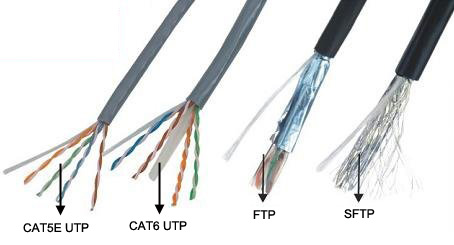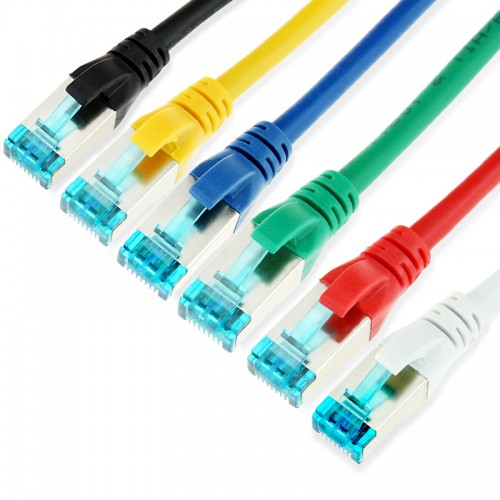0
Cablexa Cat5e Snagless / Molded Boot FTP Ethernet Network Patch Cable
| Product Name/Code: FTP Cat 5E PVC | Performance | |||||
| Application: | Frequency | RL | Attenuation | NEXT | PSNEXT | |
| 100 Base-T4 | (MHz) | (dB) | (dB/100m) | |||
| 100 Base-TX | min. | max | min (dB) | min (dB) | ||
| 100VG - AnyLAN | 0.722 | 22.60 | 1.82 | 67.00 | 64.00 | |
| 1000 Base-T (Gigabit Ethernet) | 1.000 | 23.10 | 2.00 | 65.30 | 62.30 | |
| 155 Mbps ATM | 4.000 | 23.00 | 4.10 | 56.30 | 53.30 | |
| 622 Mbps AT | 8.000 | 24.50 | 5.80 | 51.80 | 48.80 | |
| Reference Standard | 10.00 | 25.00 | 6.50 | 50.30 | 47.30 | |
| EIA/TIA 568B & ISO/IEC 11801 | 16.00 | 25.00 | 8.20 | 47.30 | 44.30 | |
| Cable Construction | 20.00 | 25.00 | 9.30 | 45.80 | 42.80 | |
| Conductor | Solid Bare Copper | 25.00 | 24.20 | 10.23 | 44.30 | 41.30 |
| AWG | 24 | 31.25 | 23.30 | 11.71 | 42.90 | 39.90 |
| Conductor Diameter(mm) | 0.53 | 62.50 | 20.70 | 17.25 | 38.40 | 35.40 |
| Insulation | Solid PE | 100.00 | 19.24 | 22.00 | 35.30 | 32.30 |
| Average Thickness (mm) | 0.2 | Frequency | ELFEXT | PSELFEXT | ACR | |
| Insulation Diameter(mm) | 1.00 | (MHz) | ||||
| Drain wire | Tinned copper | min (dB) | min (dB) | |||
| Construction (mm) | 7/0.2 | 0.722 | 66.00 | 63.00 | 65.00 | |
| Al foil | Aluminium/PET fiol | 1.000 | 63.8 | 60.8 | 63.30 | |
| 4.000 | 51.7 | 48.7 | 52.20 | |||
| 8.000 | 45.7 | 42.7 | 46.00 | |||
| Sheathing | PVC /FRPVC | 10.00 | 43.8 | 40.8 | 43.80 | |
| Thickness(mm) | 1.4 | 16.00 | 39.7 | 36.7 | 39.10 | |
| Diameter(mm) | 5.8 | 20.00 | 37.7 | 34.7 | 36.50 | |
| 25.00 | 35.8 | 32.8 | 33.90 | |||
| Core Identificatin/Color Code | According to customer request | 31.25 | 33.9 | 30.9 | 31.20 | |
| Bending Radius | 6xOverall Diameter | 62.50 | 27.8 | 24.8 | 21.40 | |
| 100.00 | 23.8 | 20.8 | 13.30 | |||
| Fire Performance | Electrical Performance | |||||
| Flame propagation Test to IEC 332 Part 1(PVC) Flame Propagation Test to IEC 60332 Part 1 and Part 3(FRPVC) | Max.Conductor DC Resistance at 20 ℃(Ω/Km) | <93.8 | ||||
| Operating Temperature( ℃ ) | 70 | |||||
| Velocity of propagation | 68% | |||||
| Impedance(ohm) | 100±15 | |||||
UTP, FTP and SFTP Standards
UTP (Unshielded Twisted Pair)
Used primarily for data transmission in local area networks (LANs), UTP network cable is a 4-pair, 100-ohm cable that consists of 4 unshielded twisted pairs surrounded by an outer jacket. Each pair is wound together for the purposes of canceling out noise that can interfere with the signal. UTP cabling systems are the most commonly deployed cable type in the world.
F/UTP (foil unshielded twisted pair)
F/UTP cable consists of four unshielded twisted pairs surrounded by an overall foil shield. F/UTP has also been referred to as STP (screened twisted pair) and FTP (foiled twisted pair). F/UTP cable is not as common as UTP, but is sometimes deployed in environments where electromagnetic interference (EMI) is a significant concern. With shielded systems, the foil shield must maintain continuity throughout the entire system.
SFTP (shielded foil twisted pair)
SFTP consists of four foil-shielded twisted pairs surrounded by an overall braided shield. This fully shielded cable is often referred to as PiMF (pairs in metal foil), or SSTP. It is the primary cable type deployed in Europe, but rarely seen in the U.S. With shielded systems, the foil shield must maintain continuity throughout the entire system.

Category 5, 5e, 6, 6a and 7 Cable Standards
Cat5 Cable
Category 5 (CAT5) cable is a multi-pair (usually 4 pair) high performance cable that consists of twisted pair conductors, used mainly for data transmission. Basic CAT5 cable was designed for characteristics of up to 100 MHz. CAT5 cable is typically used for Ethernet networks running at 10 or 100 Mbps.
Cat5e Cable
Category 5e (CAT5e) cable, also known as Enhanced Category 5, is designed to support full-duplex Fast Ethernet operation and Gigabit Ethernet. The main differences between CAT5 and CAT5e can be found in the specifications. The performance requirements have been raised slightly in the new standard (see comparison chart below).
CAT5e has stricter specifications for Power Sum Equal-Level Far-End Crosstalk (PS-ELFEXT), Near-End Crosstalk (NEXT), Attenuation, and Return Loss (RL) than those for CAT5. Like CAT5, CAT5e is a 100-MHz standard, but it has the capacity to handle bandwidth superior to that of CAT5. CAT5 cable is typically used for Ethernet networks running at 100 Mbps or 1 Gbps.
Cat6 Cable
Category 6 (CAT6) cable provides higher performance than CAT5e and features more stringent specifications for crosstalk and system noise.
The quality of the data transmission depends upon the performance of the components of the channel. To transmit according to CAT6 specifications, jacks, patch cables, patch panels, cross-connects, and cabling must all meet CAT6 standards. The CAT6 components are tested individually, and they are also tested together for performance. In addition, the standard calls for generic system performance so that CAT6 components from any vendor can be used in the channel.
All CAT6 components must be backward compatible with CAT5e, CAT5, and CAT3. If different category components are used with CAT6 components, then the channel will achieve the transmission performance of the lower category. For instance, if CAT6 cable is used with CAT5e jacks, the channel will perform at a CAT5e level.
Cat6a Cable
CAT6a is a 10-Gigabit Ethernet over copper proposal to the CAT6 standard. The IEEE published a draft standard (Std 802.3an) in October 2004. The draft calls for 10-Gigabit data transmission over a 4-pair twisted-pair copper cable for a distance of 100 meters on Class F or Class E-augmented copper cabling. The draft extends CAT6 electrical specifications from 250 MHz to 500 MHz. It also proposes a new measurement: Power-Sum Alien Crosstalk to 500 MHz. Alien Crosstalk is a coupled signal in a disturbed pair arising from a signal in a neighboring cable.
The TIA is working to complete a new specification that will define enhanced performance standards for unshielded twisted pair cable systems. Draft specification ANSI/TIA/EIA-568-B.2-10 specifies cable systems, called "Augmented Category 6" or more frequently as "Category 6a", that operate at frequencies up to 500 MHz and will provide up to 10 Gbit/s bandwidth. The new specification has limits on alien crosstalk in cabling systems.
Augmented Category 6 specifies cable operating at minimum frequency of 500 MHz, for both shielded and unshielded. It can support future 10 Gb/s applications up to the maximum distance of 100 meters on a 4-connector channel.
Within the networking market place the move towards the ratification of Category 6 Augmented cabling is continuing, but with no firm standards set, it is a time to wait and see. Although a number of companies have announced Cat6A products, it is clear that these are purely based on proprietary systems, with a great deal of hope thrown in. The basic drive behind Cat6A is the desire to support 10Gbps to the desk over the standard 100m. Although the current Cat6 standard will support it up to 55m, this is not suitable for most organisations.
Cat7 Cable
Category 7/Class F (ISO/IEC 11801:2002) specifies a frequency range of 1–600 MHz over 100 meters of fully shielded twisted-pair cabling. It encompasses four individually shielded pairs inside an overall shield, called Shielded/Foiled Twisted Pair (S/FTP) or Foiled/ Foiled Twisted Pair (F/FTP). There is a pending class Fa, based on the use of S/FTP cable to 1000 MHz. It can support 10GBASE-T transmissions.
With both types of cable, each twisted pair is enclosed in foil. In S/FTP cable, all four pairs are encased in an overall metal braid. In F/FTP, the four pairs are encased in foil.
Category 7/Class F cable can be terminated with two interface designs as specified in IEC 6063-7-7 and IEC 61076-3-104. One is an RJ-45 compatible GG-45 connector. The other is the more common TERA connector, which was launched in 1999.
Category 7/Class F is backwards compatible with traditional CAT6 and CAT5 cable, but it has far more stringent specifications for crosstalk and system noise. The fully shielded cable virtually eliminates crosstalk between the pairs. In addition, the cable is noise resistant, which makes the Category 7/Class F systems ideal for high EMI areas, such as industrial and medical imaging facilities. Category 7/Class F cable can also increase security by preventing the emission of data signals from the cable to nearby areas.
| Category 5, 5e, 6 & 7 Cable Comparison | |||||
| Cat5 | Cat5e | Cat6 | Cat6a | Cat7 | |
| Frequency | 100 MHz | 100 MHz | 250 MHz | 500 MHz | 600 MHz |
| Attenuation (min. at 100 MHz) | 22 dB | 22 dB | 19.8 dB | -- | 20.8 dB |
| Characteristic Impedance | 100 ohms = 15% | 100 ohms = 15% | 100 ohms = 15% | -- | 100 ohms = 15% |
| NEXT (min. at 100 MHz) | 32.3 dB | 35.3 dB | 44.3 dB | 27.9 dB | 62.1 dB |
| PS-NEXT (min. at 100 MHz) | NA | 32.3 dB | 42.3 dB | -- | 59.1 dB |
| EL-FEXT (min. at 100 MHz) | NA | 23.8 dB | 27.8 dB | 9.3 dB | NA |
| PS-ELFEXT (min. at 100 MHz) | NA | 20.8 dB | 24.8 dB | -- | NA |
| PS-ANEXT (min. at 500 MHz) | -- | -- | -- | 49.5 dB | -- |
| PS-AELFEXT (min. at 500 MHz) | 16 dB | 20.1 dB | 20.1 dB | 23.0 dB | 14.1 dB |
| Return Loss (min. at 100 MHz) | 16 dB | 20.1 dB | 20.1 dB | 8.0 dB | 14.1 dB |
| Delay Skew (max. per 100m) | NA | 45 ns | 45 ns | -- | 20 ns |
| Networks Supported | 100BASE-T | 1000BASE-T | 1000BASE-TX | 10GBASE | NA |





















